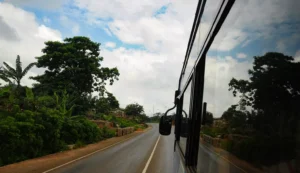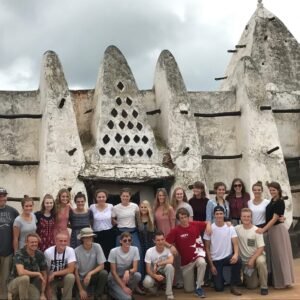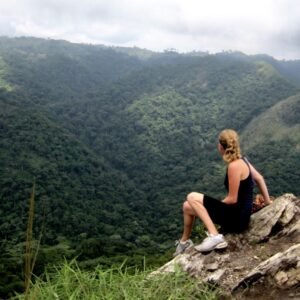Ghana is a deeply spiritual country where religion is woven into the fabric of daily life. From centuries-old mosques and Christian cathedrals to sacred groves, shrines, and vibrant pilgrimage sites, the country offers a wide array of spiritual destinations that attract both devotees and curious travelers. Whether you’re seeking architectural wonders, ancestral rituals, or a moment of quiet reflection, Ghana’s religious sites provide meaningful insight into its diverse faith traditions.
Here are the top religious and spiritual destinations to visit in Ghana—each with its own history, cultural importance, and travel experience.
1. Larabanga Mosque – Ghana’s Oldest Mosque
Location: Larabanga, Savannah Region (near Mole National Park)
Established: 15th century
Known as the “Mecca of West Africa,” the Larabanga Mosque is Ghana’s oldest Islamic structure and one of the most iconic examples of Sudano-Sahelian architecture.
Why Visit:
- Built from mud and stick using ancient techniques
- Houses a Quran believed to have descended from heaven
- Deep historical and spiritual relevance for West African Muslims
Visitor Info:
- Non-Muslims are not allowed inside but can tour the exterior
- Modest dress is required
- Local guides explain its history and significance
Combine With: A safari at nearby Mole National Park
2. National Mosque of Ghana – Accra’s Grandest Islamic Site
Location: Kanda, Accra
Completed: 2021
A massive and ornate structure built with Turkish-Ghanaian collaboration, the National Mosque is the largest in Ghana and one of the largest in West Africa.
Highlights:
- Ottoman-style architecture with marble interiors and domes
- Capacity of over 15,000 worshippers
- Surrounding complex includes a library, school, and conference center
Best Time to Visit: Outside of Friday prayers for less crowd
Visitor Tip: Guided tours are available—contact ahead for arrangements
3. The Akropong-Akuapem Presbyterian Seminary & Basel Mission
Location: Akropong, Eastern Region
Established: 1835
One of the first mission posts of the Basel missionaries in Ghana, this seminary laid the foundation for Christian education in the country.
Why Visit:
- Old missionary buildings and archives
- Historic cemetery where early Swiss missionaries are buried
- Deep cultural ties between the Christian faith and Ghanaian communities
Tip: The surrounding Akuapem Hills also provide scenic hikes and cooler climate.
4. St. Peter’s Cathedral Basilica – The Catholic Heart of Kumasi
Location: Roman Hill, Kumasi
This towering basilica is one of Ghana’s most architecturally significant Catholic churches and a center of Catholic activity in the Ashanti Region.
Highlights:
- Elegant stained-glass windows and Gothic design
- Hosts important masses, feast days, and ordinations
- Located near the Kejetia Market for easy touring
Travel Tip: Attend Sunday mass for an experience of Ghanaian choral worship.
5. The Christ the King Cathedral – Sunyani
Location: Sunyani, Bono Region
A symbol of faith and identity in the Bono Region, this cathedral blends modern design with cultural elements.
Best For:
- Visitors interested in Catholicism outside urban centers
- Viewing regional architecture styles and Christian outreach programs
Note: Check mass times in advance—Sun services are especially lively.
6. Mount Afadjato and Tagbo Falls – Spiritual Hiking in Nature
Location: Liati Wote, Volta Region
Mount Afadjato Elevation: 885 meters (highest in Ghana)
While not a religious site in the traditional sense, Mount Afadjato and nearby Tagbo Falls are considered spiritually significant by the local Ewe people.
Why Visit:
- Nature and spirituality intertwined—used for ancestral rituals
- Sacred groves and traditional stories tied to the landscape
- Excellent for those seeking meditative hiking experiences
Travel Tip: Hire a local guide to explain the sacred significance of the area.
7. Tenzug Shrine – Sacred Rocks and Traditional Faith
Location: Tongo Hills, Upper East Region
Tenzug is one of Ghana’s most intriguing spiritual sites, with ancestral shrines embedded in cliffs and caves.
What to Expect:
- Shirtless entry required as a sign of humility and respect
- Rituals conducted by traditional priests
- Historic caves used during tribal wars and for spiritual protection
Respect Local Customs: Always follow guide instructions, as this is an active spiritual site.
8. Our Lady of Seven Sorrows Cathedral – Navrongo
Location: Navrongo, Upper East Region
Built: 1906
This cathedral, also known as the Mud Cathedral, is made entirely of laterite clay and timber—an outstanding example of adapting Christianity to local building traditions.
Why Visit:
- Oldest Catholic structure in northern Ghana
- Hand-painted interior with African symbols and Catholic iconography
- Peaceful and reflective atmosphere
Pair With: Visits to Bolgatanga market or Paga Crocodile Pond nearby.
9. Amedzofe Episcopal Church and Seminary
Location: Amedzofe, Volta Region
Built in the late 1800s by German missionaries, this stone church sits in the tranquil Avatime Hills and is one of the highest-altitude churches in Ghana.
Best For:
- History lovers and architecture enthusiasts
- Cool climate and serene mountain backdrop for reflection
Nearby: Hike Mount Gemi and explore Ote Falls
10. Pentecost Convention Centre (PCC) – Kasoa
Location: Gomoa Fetteh, Central Region
One of the largest Christian retreat centers in West Africa, PCC hosts thousands of worshippers during annual conventions and revivals.
Experience:
- Charismatic Pentecostal services
- Regional and international Christian gatherings
- Modern accommodations and large auditoriums
Note: Open to non-members with permission. Major conventions typically held in August and December.
Bonus: Prayer Camps and Revival Grounds
All across Ghana, especially near Accra, Kumasi, and Koforidua, you’ll find prayer camps, which are spiritual centers where people seek healing, deliverance, or spiritual guidance.
Popular Ones:
- Mount Horeb Prayer Centre – Mamfe
- Achimota Forest Prayer Grounds – Accra
- Ejisu Prayer Camps – Ashanti Region
Caution: These are not tourist sites. Only visit with someone familiar or after gaining permission. Respect the spiritual nature of the space.
Travel Tips for Religious Sites in Ghana
- Dress modestly, especially when visiting mosques, shrines, and churches.
- Ask for permission before taking photos, especially in rural or sacred areas.
- Make donations when appropriate, particularly at community-run shrines or mosques.
- Avoid visiting during services unless you intend to participate respectfully.
- Use local guides to gain deeper cultural context and avoid unintentional disrespect.
Conclusion
Ghana’s religious and spiritual destinations are not just monuments—they’re living centers of faith, culture, and identity. Whether you’re tracing Islamic history in Larabanga, marveling at Christian cathedrals in Kumasi and Navrongo, or exploring ancestral shrines in the Upper East, these sites offer powerful experiences that go beyond sightseeing.
For any traveler seeking to understand Ghana’s soul, its sacred spaces are essential stops on the journey.




